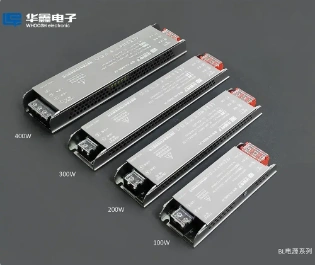What Power Supply Do I Need for LED Lights?
When it comes to LED lighting systems, the power supply (also called a driver or transformer) is the heart that keeps your lights glowing safely and efficiently. LEDs run on low DC voltage, while most outlets provide high AC voltage. The power supply bridges this gap, converting AC to DC and regulating the current so your LEDs don’t burn out.

Why the Right Power Supply Matters
If you’re running a retail store, an office, or even a DIY home setup, choosing the correct LED power supply means better light quality and fewer replacements.
Efficiency: A mismatched supply can waste energy, leading to higher utility bills.
Safety: Overloading or underpowering LEDs can cause overheating or short circuits.
Lifespan: The right driver ensures consistent voltage, protecting your LEDs for years.
Compliance: Proper selection ensures compliance with electrical codes and building standards — essential for commercial setups.
Types of LED Power Supplies
1. Constant Voltage Power Supplies
Constant voltage power supplies deliver a fixed output voltage, typically 12V or 24V. They are best suited for LED strips, signage, or accent lighting applications and are used when LEDs are connected in parallel. For example, a 12V LED strip should be paired with a 12V power supply.
2. Constant Current Power Supplies
Constant current power supplies regulate the current, measured in milliamps or amps, while the voltage may vary. Great for high-power LEDs, downlights, or spotlights, these help stop thermal runaway, which can burn out LEDs faster.
3. Dimmable Power Supplies
Dimmable power supplies allow adjustable brightness and require a dimmable driver that is compatible with the lighting control system. The main types include TRIAC (phase-cut), 0-10V, and DALI dimmers. They are particularly suitable for retail stores or offices that aim to achieve mood and energy control.
How to Choose the Right Power Supply for LED Lights
Match the Voltage: Always match the output voltage of the power supply with your LED product’s voltage rating. If your LED strip is 24V, use a 24V DC power supply.
Calculate the Total Wattage: Add up the total wattage of your LEDs and multiply by 1.2 (to include a 20% safety margin). Example: 5m of LED strip × 4W/m = 20W → 20W × 1.2 = 24W power supply.
Choose the Right Current (for Constant Current LEDs): Check your LED’s current rating (e.g., 350mA, 700mA). The power supply must match this exactly.
Consider the Environment: If installing outdoors or in humid locations, look for IP65 or higher-rated waterproof power supplies.
Practical Example: Small Business LED Setup
In a small business setup, a retail store installs 10 meters of 24V LED strip lighting with a total power draw of 100W. Adding a 20% margin requires a 24V, 120W constant voltage power supply (IP65 if near moisture). This setup ensures stable brightness, low heat, and long-term reliability for displays running over 10 hours daily.
FAQs about LED Power Supplies
1. Can I use any power supply for LED lights?
No. You must use one that matches your LED’s voltage and current requirements, or you risk damage and reduced lifespan.
2. What happens if I use a higher voltage power supply?
It can burn out your LEDs almost instantly. Always match voltage ratings exactly.
3. How do I know if my power supply is failing?
Watch for flickering, dimming, or inconsistent lighting — these often signal driver issues.
4. What’s the best power supply for outdoor LEDs?
Look for waterproof models with an IP65 or IP67 rating, ideally with surge protection.
5. Are dimmable power supplies worth it?
Yes. They save energy and extend LED life, especially in commercial spaces where lighting control matters.
The Right Power Supply Powers Success
The right power supply is the foundation of a safe, efficient, and visually stunning setup. A good power supply might seem minor, but it really boosts reliability and keeps things safe.
 EN
EN AR
AR NL
NL FR
FR DE
DE EL
EL HI
HI IT
IT KO
KO PL
PL PT
PT RU
RU ES
ES TL
TL IW
IW ID
ID UK
UK VI
VI HU
HU TH
TH TR
TR FA
FA MS
MS SW
SW AZ
AZ UR
UR BN
BN KK
KK